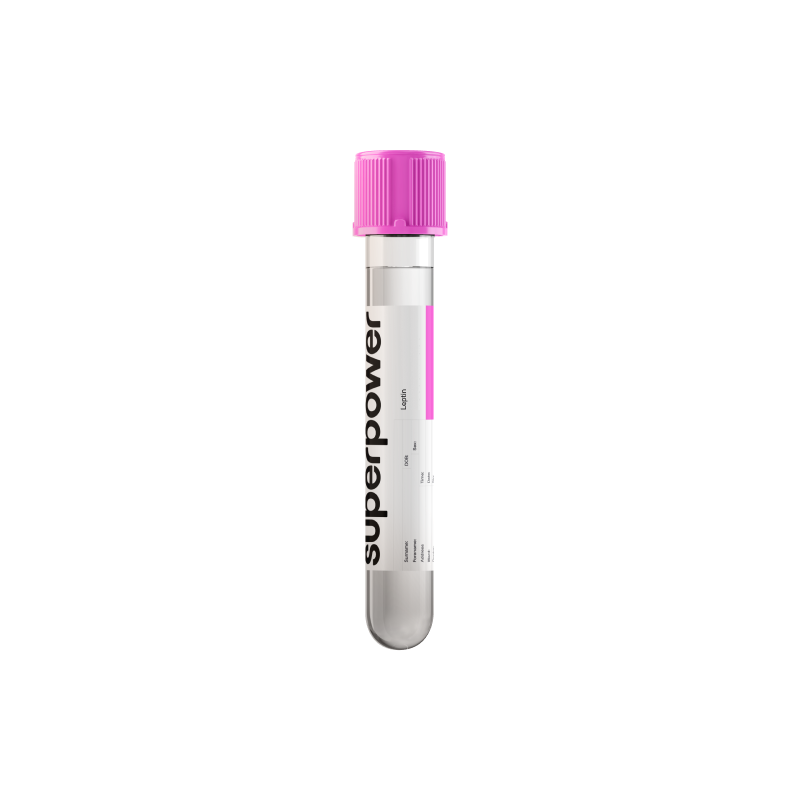Key Benefits
- Measure your body’s satiety hormone to understand fat stores and appetite signaling.
- Spot leptin resistance and metabolic strain; high levels often reflect obesity and insulin resistance.
- Clarify unexpected leanness with metabolic issues; low leptin suggests fat-loss disorders such as lipodystrophy.
- Explain persistent hunger or weight regain during dieting; falling leptin drives appetite increases.
- Guide evaluation of missed periods or low libido; very low leptin flags hypothalamic amenorrhea.
- Support therapy decisions in generalized lipodystrophy or leptin deficiency; very low leptin guides metreleptin.
- Track body-fat change over time; leptin trends mirror fat mass and metabolic adaptation.
- Best interpreted with BMI, waist size, fasting insulin, glucose, and symptoms.
What is Leptin?
Leptin is a hormone produced mainly by white fat cells (adipocytes) and released into the bloodstream. It is a small protein (peptide hormone) encoded by the LEP gene and binds the leptin receptor (LEPR). Because it is made in proportion to the amount of body fat, circulating leptin mirrors stored energy (adiposity). Smaller amounts also come from the placenta and stomach, but adipose tissue is the primary source. The brain’s appetite center (hypothalamus) is its key target.
Leptin’s job is to tell the brain how much fuel is on board and to adjust eating and energy use accordingly (energy homeostasis). When fat stores are sufficient, leptin signals satiety, dampens hunger-driving pathways (NPY/AgRP), supports fullness-promoting pathways (POMC/CART), and nudges the body to burn more energy and heat (thermogenesis). It also coordinates broader neuroendocrine functions—reproductive, thyroid, and stress axes (HPG, HPT, HPA)—and influences glucose and lipid handling, immunity, and bone remodeling. In short, leptin is the body’s long-term gauge of fat reserves.
Why is Leptin important?
Leptin is the hormone voice of body fat. Made by adipose tissue and read by the hypothalamus, it reports energy stores and helps the brain coordinate appetite, metabolic rate, fertility, thyroid tone, immune activity, and bone building. It’s a systems signal, not just a “fullness” switch.
Reference intervals vary by lab, sex, and body fat. Levels rise with total fat mass and are naturally higher in women than men, increase with puberty, and are elevated in pregnancy due to placental production. For a given body composition, values that fall in the middle of the expected range tend to reflect a clear, effective signal.
When leptin is lower than expected for someone’s fat mass, the brain reads scarcity. Hunger rises, resting metabolism and body temperature drift down, and fatigue and cold intolerance are common. The thyroid axis shifts toward lower T3, and the reproductive axis slows—missed periods or infertility in women; low libido and reduced sperm parameters in men; delayed puberty in teens. Bone formation falls, raising stress‑fracture risk, and immune defenses can be muted. Rare genetic deficiency causes profound hyperphagia and early‑onset obesity despite very low levels.
When leptin is high—most often with increased fat mass—the signal can be ignored centrally (leptin resistance). Satiety is blunted, sympathetic tone and blood pressure may climb, inflammation increases, and insulin resistance, fatty liver, and cardiovascular risk rise. High levels in pregnancy are physiologic.
Big picture: leptin links fat stores to the brain and, through neuroendocrine loops, to metabolism, reproduction, immunity, and bone. Persistently distorted signaling—too little or resistantly high—tracks with risks such as infertility, osteoporosis, type 2 diabetes, fatty liver, and heart disease.
What Insights Will I Get?
Leptin is a hormone made by fat cells that signals how much energy is stored. It calibrates appetite and energy expenditure and gates neuroendocrine functions—reproduction, thyroid, stress—while influencing glucose handling, vascular function, bone, and immune activity.
Low values usually reflect low fat mass or an acute energy shortfall. The brain reads scarcity: hunger rises, metabolic rate falls, and reproductive and thyroid axes are suppressed (hypogonadotropic hypogonadism, low T3). In women it links to amenorrhea and reduced bone formation; in youth, delayed puberty. Rare congenital deficiency causes severe early hyperphagia with obesity despite very low leptin.
Being in range suggests adequate energy stores with intact leptin signaling between fat and brain. This supports stable appetite, normal menstrual or testosterone status, healthy thyroid tone, and good insulin sensitivity. In healthy adults, values often sit in the lower-to-mid range appropriate for sex and body fat.
High values usually reflect greater fat mass with central leptin resistance. Signals of abundance fail to curb intake or raise expenditure, and risk rises for insulin resistance, fatty liver, and hypertension. Leptin also amplifies inflammatory signaling, adding cardiometabolic risk. Pregnancy and chronic kidney disease can elevate leptin independent of fat mass.
Notes: Interpret leptin in context of sex, age, and adiposity; women and pregnancy run higher than men at the same fat mass. Use morning fasting samples to limit diurnal swings. Acute illness, short-term overfeeding, glucocorticoids, assay differences, and reduced kidney function can raise levels.



.svg)



.png)
.png)
.png)
.png)








